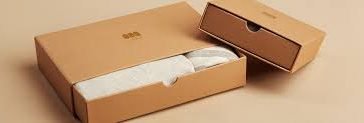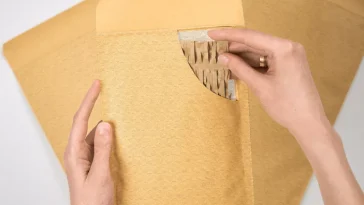To prepare dielines for prepress and printing, you need to create a clear template that shows where to cut, fold, and leave extra space (called bleed) for printing. Dielines are like a map for printers, ensuring your design is printed and assembled just right.
They help avoid errors like misaligned cuts or missing parts, saving you time and money. Commonly used for packaging like boxes, labels, and pouches, dielines make sure your final product turns out as planned.
This blog will guide you through everything you need to know, including what dielines are, how to create them, tools to use, common mistakes, and tips for working with printers.
What is a Dieline?
A dieline is a template that shows the exact shape and layout of a printed product, like a box or label. It guides where to cut, fold, or crease the material during production.
Dielines include important details like cutting lines, folding marks, bleed areas, and safety zones to make sure the design fits perfectly when printed and assembled. They are typically created by graphic designers, die cutters, or printers and are widely used in packaging production. They include key details such as:
- The size, scale, and dimensions of the packaging
- Placement of visual elements
- Locations of cut lines, folds, creases, tabs, and connection points
- Manufacturing instructions
- Bleed area specifications
Important Factors to Consider Before Creating a Dieline
Before starting dieline creation, several key factors need to be evaluated to ensure your packaging meets both product and production requirements.
1- Determine the Size
The size of your packaging is the first and most important consideration. It should be just large enough to fit your product comfortably without wasting material. Oversized packaging can lead to higher costs and production challenges.
Keep in mind that dielines are printed on sheets designed to fit industry-standard sizes. Choosing an excessively large packaging size might exceed the printer’s sheet limits, complicating the die-cutting process or even making production impossible for oversized projects.
2- Assess the Product’s Weight
The weight of your product directly impacts the material you’ll need for your packaging. Heavier items typically require sturdier materials, such as corrugated cardboard or thicker paperboard, to provide sufficient support and protection.
This choice affects the complexity of the dieline, as stronger materials might need additional design elements like reinforced flaps or structural supports.
3- Understand the Packaging Purpose
The function of your packaging will influence its design and the dieline you’ll create. Packaging requirements differ based on whether you’re shipping products directly to customers or displaying them in a retail setting.
For E-commerce Businesses
Packaging for shipping often prioritizes durability and protection. Dielines for e-commerce may include thicker materials like corrugated cardboard and extra flaps or tabs for cushioning. These additions ensure that products remain secure during transit and arrive in excellent condition.
For Retail Businesses
Packaging for retail typically focuses on visual appeal and shelf presence. Dielines in this context may involve lighter materials, such as folding cartons or rigid boxes, with fewer flaps and simpler construction. The emphasis is on showcasing the product rather than withstanding shipping stress.
4- Align Packaging Design with Industry Needs
Your industry and business type will determine specific packaging requirements:
Shipping Considerations
If your business involves shipping, consider how the packaging will endure handling and transit. Design dielines to account for additional cushioning or reinforced sections.
Shelf Impact
Retail packaging should be according to attract customers, so dielines might focus more on shape and design elements that make the product stand out on the shelf.
Tools & Software for Creating Dielines
Preparing accurate dielines requires the right tools and software that can handle the precision and flexibility needed for packaging design. Here’s an overview of the best tools and software you can use to create professional dielines.
- Adobe Illustrator
- CorelDRAW
- ArtiosCAD
- Esko Studio
- Packly
Pre-Made Dieline Templates
Creating a box dieline involves numerous technical details, which can make the process complex. To simplify this, custom packaging companies or manufacturers often provide ready-made dieline templates.
These templates ensure the structural design of your packaging is accurate, leaving you with the task of positioning your artwork and logos and ensuring the colors align correctly for printing.
How to Choose the Right Software for Dieline Creation?
When selecting software for dieline creation, ensure it includes these critical features:
- Vector Graphics Support – Essential for creating scalable and accurate designs.
- Layer Management – To keep dieline components (cut lines, fold lines, bleed) organized and distinguishable.
- Spot Color Support – For color-coding dieline elements, which is crucial for clarity in prepress.
- 3D Modeling – To visualize the packaging’s final structure and identify potential design flaws.
- Export Formats – Compatibility with industry-standard formats like PDF, AI, and EPS for seamless communication with printers.
- Prepress Tools – Features like bleed area settings, alignment tools, and preflight checks help ensure the dieline is production-ready.
Step-by-Step Guide to Preparing Dielines
Creating dielines requires precision and attention to detail to ensure the design transitions from concept to production. Follow this step-by-step guide to prepare accurate dielines:
Step 1: Define the Packaging Dimensions
Start by determining the exact size and dimensions of your packaging. This includes the height, width, and depth for boxes or the diameter and length for cylindrical designs. Accurate measurements are critical for ensuring the dieline fits the product perfectly.
Step 2: Create the Basic Layout
Using vector graphic software like Adobe Illustrator, set up an artboard that matches the dimensions of your packaging. Draw the flat layout of the packaging, including panels, flaps, and tabs. Use precise measurements and ensure that each section is proportionate to the overall structure.
Step 3: Add Cut Lines
Add solid lines to indicate where the material will be trimmed. These lines define the outer shape of the packaging. Ensure they are placed accurately, as any misalignment can result in an uneven final product.
Step 4: Mark Fold and Crease Lines
Add dashed or dotted lines to indicate folds or creases. These lines show where the packaging will be bent to create its final shape. Use a distinct color (e.g., magenta) to differentiate them from cut lines, making them easy to identify.
Step 5: Set Bleed Areas
Extend the artwork beyond the cut lines to create a bleed area, typically 3mm (1/8 inch) wide. This ensures the design reaches the edges of the packaging after trimming, preventing unwanted white borders.
Step 6: Define Safety Margins
Establish a safety margin inside the cut lines, usually 3mm (1/8 inch), where no critical design elements (like text or logos) should be placed. This ensures important content isn’t accidentally cut off or too close to the edge.
Step 7: Organize Layers
Place the dieline elements on separate layers in your design file. For example:
- One layer for cut lines
- Another for fold lines
- A separate layer for the artwork
- Label each layer clearly to make the file easy for printers to navigate.
Step 8: Add Manufacturing Notes
Include any specific instructions or details the printer or manufacturer needs to know, such as:
- Material type
- Thickness
- Special finishes (e.g., embossing, UV coating)
These notes help ensure the packaging is produced as intended.
Step 9: Include Registration Marks
Add registration marks and color bars to assist with alignment during the printing process. These are essential for ensuring accuracy and consistency in the final product.
Step 10: Proof and Review
Double-check every element of the dieline for accuracy. Use preflight tools in your design software to catch any errors. Review the dimensions, layers, and alignment to ensure everything matches the production specifications.
Step 11: Export the File
Save and export the dieline in a printer-friendly format, such as AI, PDF, or EPS.
Collaboration with Printers
Effective collaboration with your printer is crucial for ensuring your dielines are production-ready and meet all requirements. Miscommunication or overlooking essential details can lead to costly errors and delays. Here’s what you need to focus on when working with printers.
Prepress Checklist
Before submitting your dielines, it’s essential to verify key details to ensure they are accurate and meet the printer’s specifications. Here’s what to check:
- Dimensions and Layout
- Bleed and Safety Margins: (3mm (1/8 inch) bleed)
- CMYK Color Mode
- Line Accuracy: Clearly labeled, color-coded, and on separate layers for clarity
- Outline Fonts and Embed Images
- File Resolution: 300 DPI to maintain print quality
- Registration and Trim Marks
- Preflight Check: Catch errors like missing fonts or unembedded images
- File Formats for Submission: AI (Adobe Illustrator), PDF (Portable Document Format), and EPS (Encapsulated PostScript)
Wrapping it Up
Preparing dielines for prepress and printing is a vital step in packaging production. A well-made dieline acts as a precise blueprint, outlining cut lines, fold lines, bleed areas, and safety margins to ensure accurate printing and assembly.
By understanding the purpose of dielines and following a structured process, you can avoid costly mistakes like misaligned cuts or missing elements, saving time and ensuring your packaging meets professional standards.

